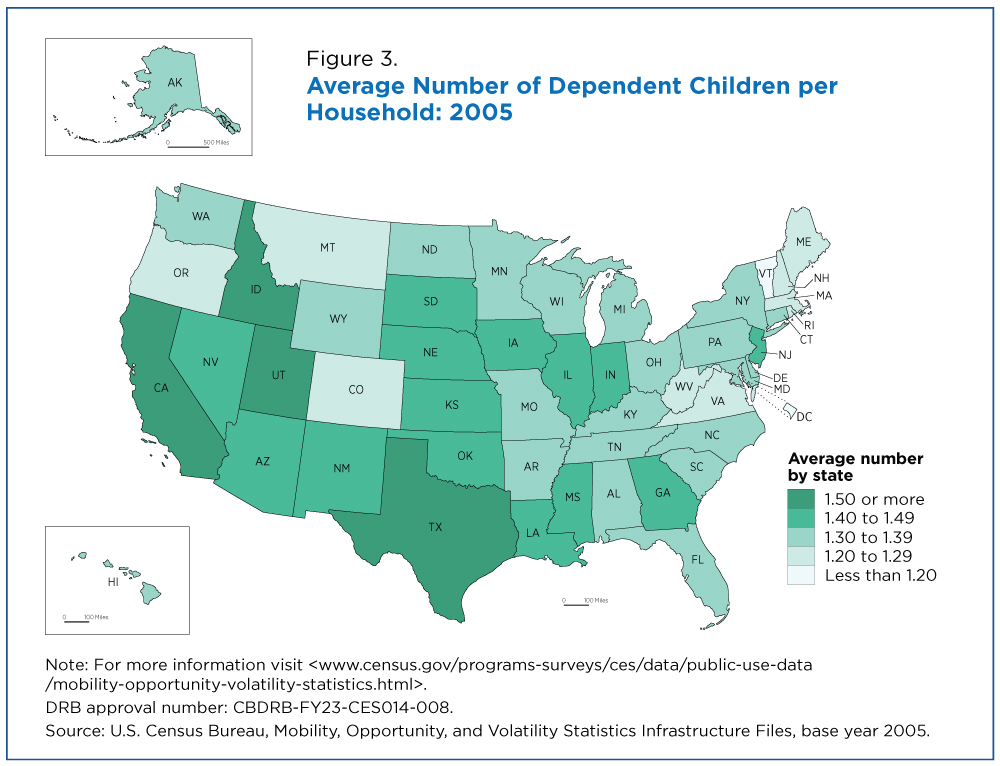New Census Project Tracks Geographic and Demographic Aspects of Income Growth Among Working-Age Adults Over Time
Black non-Hispanic men saw their incomes rise at a considerably slower rate between 2005 and 2019 than White non-Hispanic men, even among those who started out earning similar amounts. Meanwhile, Asian and White non-Hispanic men experienced the greatest income increases over the same period.
These and other findings emerge from new data released as part of the U.S. Census Bureau’s Mobility, Opportunity, and Volatility Statistics (MOVS) project.
Through an interactive data tool, MOVS offers unprecedented insight into general and group-specific patterns of income and household change over time. This sort of detail is rare in existing data, which often relies on survey snapshots in time rather than on data collected by tracking the same people over long periods of time.
A primary takeaway is that Asian and White non-Hispanic men experienced the most positive increases in average income over the period.
Income mobility refers to changes in the income of people or generations over time. It is an important measure of the economic welI-being of various groups and individuals relative to each other. For example, are children faring better than their parents? Is income growth among some racial and ethnic groups lagging others? Do men’s incomes rise faster than women’s?
In addition to measuring how income mobility varied widely across demographic groups, such as race and gender, MOVS captures changes in family structure and geographic location within these same groups.
How MOVS Measures Income
MOVS defines individual income as a person’s share of the total income in their household. This share is calculated using a common strategy called an equivalence scale.
Specifically, MOVS adjusts total household income by the square root of family size. Since the income shared in a household changes depending on the number of individuals, MOVS includes information on how family structure changes over time and by demographic group and geography, including rates of divorce and marriage and the average number of adults and children per household.
How MOVS Tracks Income
MOVS measures income and tracks income mobility through a rich combination of demographic and tax data linked at the individual level.
This unique data mix produced statistics that address income mobility questions like:
- How income growth differed for people who initially had low or high income.
- How common was it for people to move up or down the income distribution, and which groups were most likely to make such moves.
- How mobility patterns and income volatility varied by race/ethnicity, gender or a combination of the two?
- How mobility patterns varied by geography, such as state or region.
- How differences in the ways families grew or shrank over time interacted with income dynamics.
Differences in Average Incomes Over Time
MOVS data users can explore the mobility measures that interest them through an interactive data tool. They can also download the underlying aggregate data to develop more complex analyses of their own.
To make these data as broadly accessible as possible, MOVS provides scripts to help users read the data in multiple common statistical packages, along with data dictionaries and use cases, so they may perform more complex analyses.
Figure 1 is an example of how users can examine one measure of mobility — average income by group — using the interactive tool. It shows that Black non-Hispanic men (bottom map) experienced considerably lower income growth than White non-Hispanic men (upper map) between 2005 and 2015, even when we focus on groups that start with similar income levels.
The maps also show that both groups experienced higher income growth in the same parts of the country, including states such as North Dakota and Wyoming.
In another example, we leveraged the underlying data for all race-ethnicity groups and plotted average earnings over time (Figure 2).
A primary takeaway is that Asian and White non-Hispanic men experienced the most positive increases in average income over the period. In addition, while incomes stagnated for other groups during the Great Recession from 2009 to 2011, all groups began to experience positive average income growth beginning in 2012.
Figure 3 shows the importance of accounting for household structure when comparing income across geography. The map displays the mean number of children per household in 2005, providing evidence of wide differences between states in household composition.
MOVS considers how these differences in households affect the measurement of individual income, an important factor that is easily overlooked in discussions of income mobility.
Income Mobility Measures
In addition to providing intuitive visuals of income mobility patterns, MOVS incorporates the more technical statistics researchers use to develop aggregate mobility measures, which form the foundation of assessments of well-being and help inform policy.
For example, MOVS provides transition probabilities from the base-year distribution to income quintiles in future years. Data users can use these transition probabilities to calculate common overall mobility measures, such as the transition matrix below that shows how Asian and White non-Hispanic men transition from a quintile position in the initial 2005 income distribution to quintiles of the 2006 income distribution (Table 1).
The diagonals of the two matrices (shown in boldface) indicate that Asian non-Hispanic men below the top quintile (5) were more mobile than White non-Hispanic men. That is, a higher percentage of Asian non-Hispanic men moved from their original quintile position into a higher or lower quintile, and they were more likely to move up than down.
More Data, More Years
This initial release is just the beginning. The MOVS team plans to continue releasing statistics with new base years, beginning with 2006.
MOVS will be a valuable tool for better understanding how economic well-being shifted during and after the COVID-19 pandemic. Census data show that some communities — particularly communities of color and lower-income communities — were especially hard hit economically at the start of the pandemic. However, in recent years the racial income gap has begun to narrow as well as the wealth gap.
MOVS will allow us to explore the details of those emerging changes as we add more data to the tool in the coming years.
Several supplementary files will also be released with statistics focusing on the extremes of the income distribution, young adults (those ages 18–25 in 2005), and those whose incomes are persistently low.
Together, these outputs will allow users to understand income mobility in all its richness — from the big picture to the finer details.
Related Statistics
-
Stats for StoriesEqual Pay Day: March 12, 2024In 1973, full-time working women earned a median of 56.6 cents to every dollar men earned. In 2022 (49 years later), women earned 84.0, a gain of 27.4 cents.
-
DatasetMobility, Opportunity, and Volatility Statistics (MOVS)Mobility, Opportunity, and Volatility Statistics (MOVS) traces the progress of individuals' incomes over time using linked datasets on U.S. working-age adults.
Subscribe
Our email newsletter is sent out on the day we publish a story. Get an alert directly in your inbox to read, share and blog about our newest stories.
Contact our Public Information Office for media inquiries or interviews.
-
Income and Poverty2022 Income Inequality Decreased for First Time Since 2007September 12, 2023U.S. Census Bureau income data released today show declines in real income at the middle and top of the income distribution from 2021 to 2022.
-
Income and PovertyU.S. Poverty Rate Varies by Age GroupsDecember 04, 2023The poverty rate for the nation’s oldest populations was lower than for the youngest but increased in 2022 while child poverty decreased.
-
Income and PovertyIs the Gender Wage Gap the Same at Different Education Levels?February 22, 2024New data linking higher education attainment and wage records enables research showing that gender wage gap channels vary by education level.
-
EmploymentThe Stories Behind Census Numbers in 2025December 22, 2025A year-end review of America Counts stories on everything from families and housing to business and income.
-
Families and Living ArrangementsMore First-Time Moms Live With an Unmarried PartnerDecember 16, 2025About a quarter of all first-time mothers were cohabiting at the time of childbirth in the early 2020s. College-educated moms were more likely to be married.
-
Business and EconomyState Governments Parlay Sports Betting Into Tax WindfallDecember 10, 2025Total state-level sports betting tax revenues has increased 382% since the third quarter of 2021, when data collection began.
-
EmploymentU.S. Workforce is Aging, Especially in Some FirmsDecember 02, 2025Firms in sectors like utilities and manufacturing and states like Maine are more likely to have a high share of workers over age 55.








